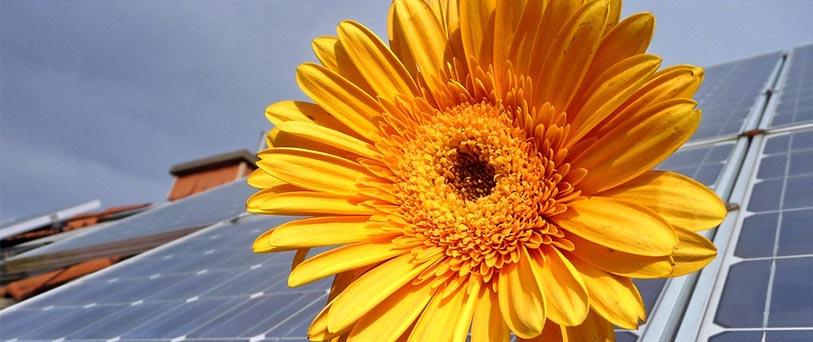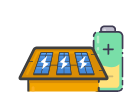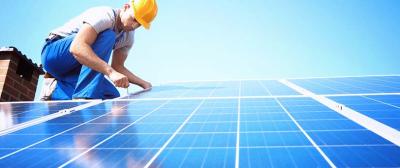How Smart Meters & Solar Panels Work Together

Smart meters provide accurate readings to energy suppliers of how much electricity that a domestic solar panel system is delivering to the National Grid. And this can help to maximise your payments through the Smart Export Guarantee (SEG).
While first generation (SMETS1) smart meters had their troubles with solar panel connection, the second generation smart meters (SMETS2) currently being rolled out by the UK government are fully compatible with solar panels.
What is a smart meter?
A smart meter measures the amount of electricity and gas being used by your property – just like a traditional meter. The key difference being that smart meters automatically deliver this information to your energy supplier via wireless communication. This provides the supplier with regular and more accurate readings so your energy bills will no longer be estimations.
Smart meters also come with an In-Home Display (IHD). This is a small screen that gives clear visibility of how much energy is being used in your property in near real-time.
Do smart meters work with solar panels?
Connectivity between solar panels and smart meters hasn't been without its problems over the years. First generation smart meters (SMETS1) could encounter compatibility issues with solar panels as energy suppliers all used their own technologies.
Fortunately, this has all changed with the roll out of second generation smart meters (SMETS2). This is because all second generation smart meters, now being rolled out by energy suppliers, are fully compatible with solar panels.
Would a smart meter benefit my home?
A smart meter could be worthwhile to homes with or without solar panels for a number of reasons:
- Provide your energy supplier with accurate meter readings to potentially lower energy bills as estimates are no longer required
- An In-Home Display (IHD) gives clear visibility of how much energy is being used in your property and how much that usage will cost
- No need for manual meter readings
- Seeing your energy usage in near real-time on the IHD can encourage better energy habits, helping to lower energy bills
Having a smart meter fitted isn't a guarantee that you'll see a decrease in your energy bills. However, powering your home with free renewable energy from the sun is one of the best ways to reduce reliance on your energy supplier and see your energy bills reduce as a result.
If you have a solar photovoltaic (PV) system then there's an additional benefit to having a smart meter:
- Accurate readings of how much electricity is being exported from your solar panels to the National Grid
This final point could help to maximise the earnings you can make through the Smart Export Guarantee.
Smart meters, solar panels and the Smart Export Guarantee
The Smart Export Guarantee (SEG) has been introduced as a replacement to the Feed-in Tariff, which ended in 2019. Through the SEG, homeowners generating renewable solar energy can receive payments from their energy supplier. The tariff is based on each unit of electricity sent to the National Grid.
During the time of the Feed-in Tariff, it was estimated that around 50% of generated solar energy was sent to the Grid. So, for any home providing more energy than that to the National Grid could have been underpaid.
Now, thanks to smart meters and the Smart Export Guarantee, homeowners will be paid more accurately for how much electricity is being sent to the Grid.
As part of the Smart Export Guarantee, UK energy suppliers that have more than 150,000 customers are under a legal obligation to pay their customers for each unit of electricity exported to the National Grid from their solar panels. Energy suppliers are free to set their own tariffs. Those suppliers with fewer than 150,000 customers can decide whether to join the SEG.
To be eligible for SEG, small-scale renewable technologies (5MW or below in size) in other forms are eligible too:
- Solar photovoltaic panels
- Hydro
- Micro-combined heat and power (with an electrical capacity of 50kW or less)
- Onshore wind
- Anaerobic digestion
Find out which energy suppliers offer the highest possible earnings to solar panel owners in Compare Smart Export Guarantee Tariffs.
What if I'm still receiving FiT payments?
Even though the Feed-in Tariff has come to an end, those already receiving payments will continue to do so for the remainder of their contract. If you are receiving FiT payments, you won't be eligible for payments through the Smart Export Guarantee too. However, if you'd rather be part of the Smart Export Guarantee then you have the right to end your FiT payments and make the switch.
In the early years of the Feed-in Tariff, the rates were much higher than towards the end of the scheme. So, if you only signed up to the FiT in the latter period then it might be worth looking to see if you can get a better rate through the Smart Export Guarantee.
Can I switch energy suppliers with a smart meter?
Switching to a new energy supplier should in theory be a smoother process if you have a smart meter. Once the switch has been made a second generation smart meter is able to deliver data to the new supplier rather than the previous one.
However, issues have been reported by homeowners with first generation smart meters when switching energy suppliers. Potential issues could include the IHD not working or the energy supplier not receiving meter readings.
If after comparing SEG tariffs you want to switch energy suppliers then you can still switch if you have a smart meter.
How to get a smart meter
Second generation smart meters are now being rolled out across the UK. Your energy supplier should be in touch to offer you one, if they haven't already done so.
If you have a first generation smart meter (SMETS1) then your energy supplier should give you the opportunity to upgrade by 2024. The deadline was originally set for 2020 but was pushed back due to energy suppliers warning that smart meter technology wasn't ready.
How much do smart meters cost?
Smart meters won't cost you anything upfront but this doesn't mean that they're free. Energy customers pay for smart meters indirectly, whether you have one or not, through their energy bills.
Is a smart meter with solar panels a good idea?
Compared to conventional meters, a smart meter offers homeowners much more in the way of benefits, especially if you have solar panels.
Since the FiT has come to an end, the SEG offers solar panel owners the best opportunity to see a return on that investment. And with a smart meter, your energy supplier will be receiving more accurate meter readings on a regular basis. This will ensure that you're paid for exactly how much energy your solar panels export to the National Grid.
Is there another way to use excess solar energy?
Solar panels are always likely to be generating more energy than can be used in a home. This is why schemes such as the Smart Export Guarantee are so beneficial to homeowners as you will receive payments in return for exporting that excess energy to the National Grid. And smart meters pay a big role in ensuring that your payments reflect the amount of electricity exported.
The alternative to exporting energy is to store it in a solar battery. This will allow you to use more of the energy generated by your solar panels. During the day, when solar panels are generating energy, excess will be stored in the solar battery. This will allow the electricity to be used in the evening or during the night when the solar panels aren't generating energy.
Will I still be eligible for the SEG with a solar battery?
If you have a solar battery you could still receive payments through the Smart Export Guarantee. However, not all tariffs will pay for energy that has been stored in a battery. This is because the energy may not be renewable solar energy and instead generated by fossil fuels. So it's worth checking the terms set by your energy supplier.
How much do solar batteries cost?
A solar battery storage unit can cost anywhere between £500 and £10,000 and even higher in some cases. This price will vary depending on the manufacturer, model, storage capacity and any other additional features. Some of the leading solar battery manufacturers include Tesla, Powerwall, LG.
In addition to the cost of the solar battery itself, you will also need to factor in the installation. Solar battery installation typically costs £500 to £2,000. To find the most competitive price for a solar battery storage unit, we highly recommend comparing multiple quotes. With Solar Guide, you can get free quotes from up to 4 solar battery installers based in your local area.
Find out more about storing solar energy in Solar Battery Storage: The Best Solar Batteries.
Smart meter or solar battery storage?
To get the most out of your solar PV system you have a number of options. When the FiT came to an end in 2019, the incentives to install solar panels took a big hit but this has now been restored with the introduction of the Smart Export Guarantee. Having a smart meter will provide your supplier with accurate readings, helping to maximise the payments you receive through the scheme. A solar battery is the best option if you're looking to hold onto more of the energy generated by your solar panels but, fortunately, you don't have to choose between the two. And by having both, you will be able to enjoy the benefits of both. Just remember the SEG terms set out by your energy supplier when having a solar battery installed.
Find local, MSC certified Solar Installers
Start your quote
Find local, MSC certified Solar Installers















